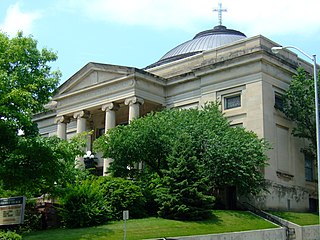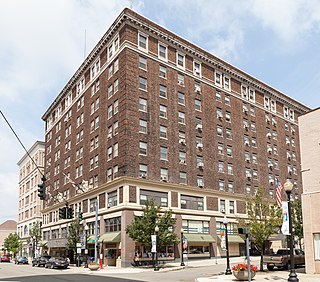
North Carolina Central University, a state-supported liberal arts institution, is a public, historically black university in Durham, North Carolina. Founded by Dr. James E. Shepard in affiliation with the Chautauqua movement in 1909, it was supported by private funds from both Northern and Southern philanthropists. It was made part of the state system in 1923, when it first received state funding and was renamed as Durham State Normal School. It added graduate classes in arts and sciences and professional schools in law and library science in the late 1930s and 1940s.

Glen Echo Park is an arts and cultural center located in Glen Echo, Maryland that, in its former incarnation, was a popular Washington, D.C.-area amusement park that operated for several decades from the early 1900s to the 1960s. The arts and cultural center takes its name from the amusement park.

Eagle Point Park is a 164-acre (0.66 km2) public park located in the northeast corner of the city of Dubuque, Iowa, United States. Eagle Point is mostly situated on a bluff that overlooks the Mississippi River and the Lock and Dam No. 11. The park is owned and operated by the city of Dubuque. It was listed as a historic district on the National Register of Historic Places in 2017. At the time of its nomination it contained 34 resources, which included 14 contributing buildings, seven contributing sites, five structures, five objects, two non-contributing buildings, and two non-contributing structures.

Midway State Park, located in Maple Springs, New York, was established in 1898 by the Jamestown & Lake Erie Railway as a picnic ground. Today, it is recognized as the fifteenth-oldest continually operating amusement park in the United States, and the fifth-oldest remaining trolley park of the thirteen still operating in the United States.

The Stone City Historic District is located in Stone City, Iowa, United States. Listed on the National Register of Historic Places as a historic district in November 2008. The buildings of Stone City Historic District were constructed using Anamosa Limestone quarried locally and built between 1870 and 1913.

St. Luke's Hospital was a hospital building on a bluff overlooking downtown Davenport, Iowa, United States. It is listed on the Davenport Register of Historic Properties and the National Register of Historic Places, and has subsequently been torn down.

Proudfoot & Bird et al. was an American architectural firm or partnership that designed many buildings in the U.S. Midwest. Partners included Willis Thomas Proudfoot (1860–1928) and George Washington Bird (1854–1953) and Harry Dustan Rawson (1872–1934). At times it was known as Proudfoot, Bird and Rawson, Proudfoot, Rawson & Souers, Proudfoot, Rawson, Souers & Thomas,Monheim, Bird & Proudfoot, Proudfoot, Rawson Brooks & Borg, Brooks - Borg Architects - Engineers, Brooks Borg and Skiles Architects Engineers, and finally BBS Architects|Engineers.

The Schauder Hotel was a historic building located in downtown Davenport, Iowa, United States. It was built in the Italianate style facing the Mississippi River, and it was listed on the National Register of Historic Places in 1983.

The Chautauqua Park Historic District is located on the north side of Des Moines, Iowa, United States. It has been listed on the National Register of Historic Places since 1990. It is part of the Suburban Development in Des Moines Between the World Wars, 1918--1941 MPS.

The Perry and Brainard Block, also known as the North Des Moines Town Hall, is a historic building located in Des Moines, Iowa, United States. The structure was built between 1888 and 1889 and the second floor served as the city hall for the suburb of North Des Moines. In the late 19th century Des Moines actively sought to annex its Victorian suburbs, with North Des Moines being the largest of these communities. This is the only known public building that has survived from the Annexation Movement era. The local government and community of North Des Moines debated annexation, not only of the municipalities, but of their schools as well. It was also the only community where the residents voted on the annexation issue, and this building also served as a polling place. The building served as the location of the celebration after the referenda passed in 1890. After its use as the city hall, the second floor became the lodge for the Ancient Order of United Workmen.

The Perry Carnegie Library Building, also known as the Carnegie Library Museum, is a historic structure located in Perry, Iowa, United States. The Perry Library Association was established in 1894, and William Tarr served as its first librarian. Andrew Carnegie accepted Perry's application for a grant for $10,600 on January 13, 1903. The Des Moines architectural firm of Liebbe, Nourse & Rasmussen designed the Neoclassical building that was built by local contractor Courtney and Bolt. It opened in September 1904 was dedicated on December 10.

The Paul–Helen Building is a historic building in downtown Iowa City, Iowa. The Chicago school building was the first part of a renewal of downtown Iowa City starting in the 1910s.

Jamestown Downtown Historic District is a national historic district located at Jamestown in Chautauqua County, New York. The district encompasses 103 contributing buildings in the central business district of Jamestown. The district developed between about 1873 and 1956, and includes buildings in a variety of architectural styles including Italianate, Gothic Revival, Second Empire, Romanesque Revival, Classical Revival, Renaissance Revival, and Art Deco. Located in the district is the separately listed Wellman Building. Other notable buildings include the Arcade Building (1898), Odd Fellows Lodge (1914), Bank of Jamestown, Hotel Samuels (1910), Hotel Jamestown (1924), Chautauqua School of Nursing (1911), Jamestown Telephone Company (1930), Maddox Building (1933), First National Bank (1953), Pennsylvania Gas Company building, Chautauqua National Bank (1956), Palace Theatre, Allen's Opera House, and the former Broadhead Worsted Mills.

The Downtown Perry Historic District, also known as Uptown, is a nationally recognized historic district located in Perry, Iowa, United States. It was listed on the National Register of Historic Places in 2000. At the time of its nomination it contained 68 resources, which included 58 contributing buildings, one contributing site, and nine non-contributing buildings. The central business district is divided into three sections: the Triangle, Second Street above Willis Avenue, and South of Otley Avenue. The Triangle is public land where the Perry Carnegie Library Building is located. Second Street above Willis Avenue is a corridor of two-blocks north of the Triangle. It is where most of the professional offices, retail and entertainment businesses are located. The area south of Otley Avenue contains a cluster of businesses that is also located along Second Street for the most part. The businesses are associated with the automobile and light industrial operations. The first two sections are included in the historic district while the third was excluded because of its mixed land use and its lack of historic integrity from alterations and demolition.

Chautauqua Park Historic District is a nationally recognized historic district located in Sac City, Iowa, United States. It was listed on the National Register of Historic Places in 2014. The park consists of the Chautauqua Auditorium, Asa Platt gates, Metcalf cabin, a fish house, a small stone bridge, and a shelter house.

The American School of Wild Life Protection Historic District is a nationally recognized historic district located on the north side of McGregor, Iowa, United States. It was listed on the National Register of Historic Places in 1991. At the time of its nomination the district consisted of 30 resources, including 17 contributing buildings, one contributing site, one contributing structure, nine noncontributing buildings, two noncontributing sites. The American School of Wild Life Protection was established in 1919 in a resort area known as McGregor Heights. The purpose of the school was to promote resource conservation values among the public. It grew out legislation in 1918 that established state parks in Iowa. The school also promoted the idea of establishing a national park in the Upper Mississippi River Valley, and after that did not come about, the Upper Mississippi River National Wildlife and Fish Refuge. The school continued in existence until 1941.

The Lewis System Armored Car and Detective Service Building, also known as the Bell Tire and Rubber Company and Sioux City Tent and Awning, is a historic building located in Sioux City, Iowa, United States. F.A. Martin and Richard Nash, who owned the property, had this two-story brick commercial building constructed in 1929. KB Construction, who built the building, occupied the second floor. Bell Tire and Rubber Company was the first business located on the first floor from 1930 to 1933. A few other businesses occupied the space until Sioux City Tent and Awning was located here from 1937 to 1941. The following year Lewis System moved in and remained until 1969. The second floor was converted into apartments about 1950.

The Hollenfelz House, also known as St. Mary's High School for Boys, is a historic building located in Dubuque, Iowa, United States. This highly decorative Second Empire structure was built as a home for Michael Hollenfelz, who owned a wholesale firm dealing with wines, liquors and beer. The building features a mansard roof with dormers and a cupola, which is normal for this style, and High Victorian decorative details, which is not. Particularly unusual is the cornice and the stringcourses. In 1906 it was acquired by St. Mary's Catholic Church across the street for a boy's high school. The school was operated by the Brothers of Mary from St. Louis, and its curriculum focused on business and commerce. That school ceased operations in 1929 and the building was then used for the parish grade school. In 1957 it was converted into an apartment building. It was individually listed on the National Register of Historic Places in 1977, and it was included as a contributing property in the Washington Residential Historic District in 2015.

Bandshell Park, also known as City Park and Music Pavilion, is located in Ames, Iowa, United States. It is a nationally recognized historic district that was listed on the National Register of Historic Places in 1999. At the time of its nomination it consisted of six resources, which included one contributing building, one contributing site, two contributing structures, one contributing object, and one non-contributing object. The park, located to the east of the central business district, was gift to the city in 1884 from the C&NW Land Company. The full city block was the first park established in Ames.

The Boerner-Fry Company/Davis Hotel is a historic building located in Iowa City, Iowa, United States. Emil Louis Boerner was born in Prussia and came to Iowa City with his family when he was 12. He was educated at the Philadelphia College of Pharmacy, and he owned and operated a drugstore in Iowa City for 57 years. He was also one of the primary organizers of the Iowa Pharmaceutical Association, a member of the faculty at the newly established Iowa College of Pharmacy in Des Moines, and was involved in establishing the Department of Pharmacy at the University of Iowa where he served as its first dean. Boerner and his partner William A. Fry had this building constructed in 1899 as a factory that produced toilet articles and light pharmaceuticals. Local contractor Jacob J. Hotz was responsible for its construction. The factory relocated to another facility in 1915, and went out of business the following year. This building was used for a variety of businesses until 1922 when it was converted into the Washington Hotel. George W. Davis renamed the hotel after himself in 1952, and he continued to operate it until 1972. It was then converted into office and retail space. The building was listed on the National Register of Historic Places in 1983.






















